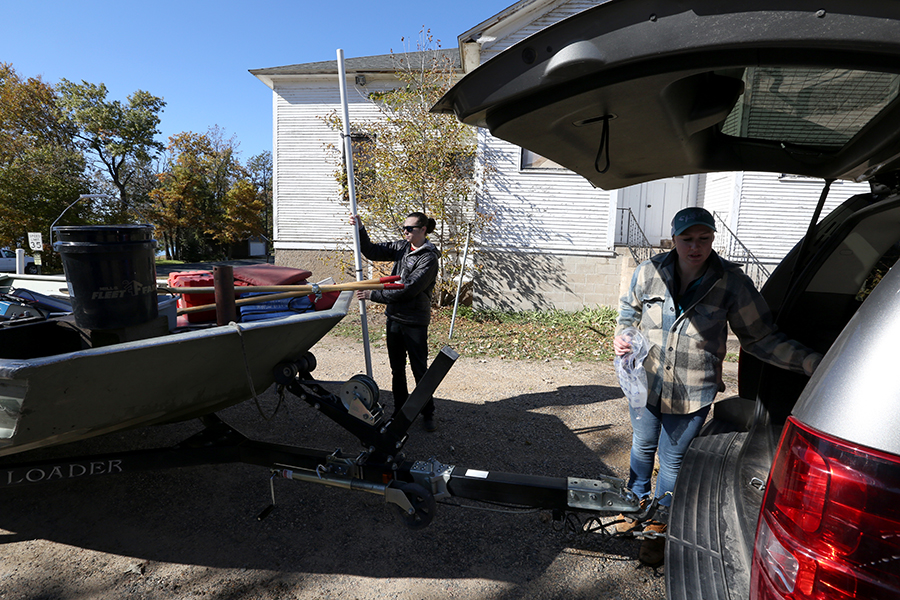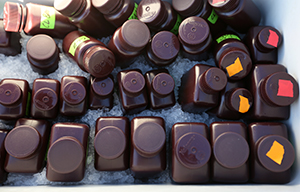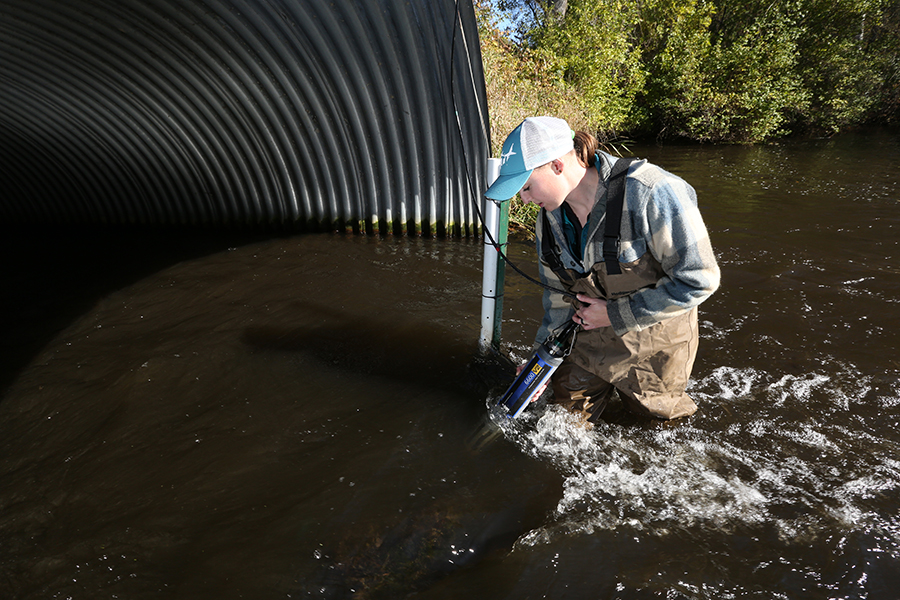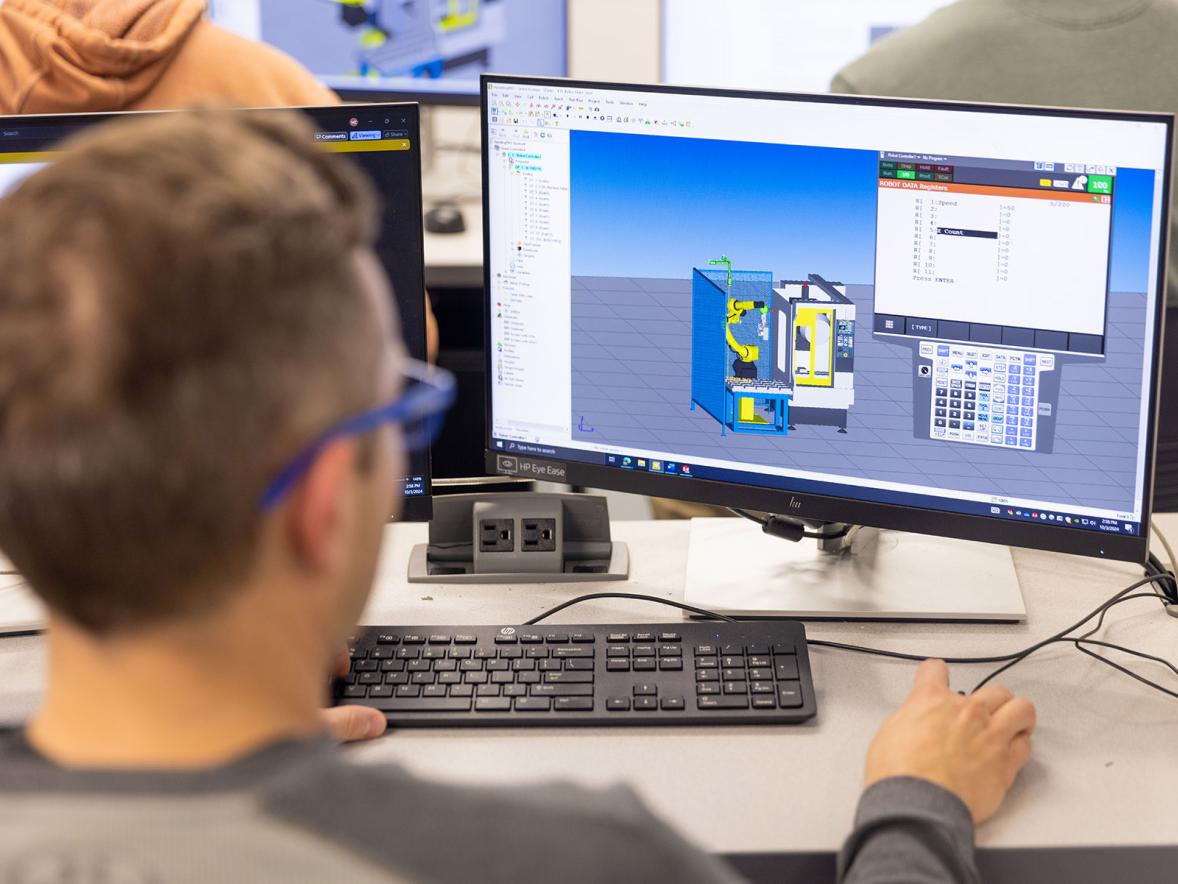Heidi Lieffort donned a pair of fishing waders and walked into Horse Creek in Star Prairie.
Using a syringe, the associate research specialist for University of Wisconsin-Stout’s Center for Limnological Research and Rehabilitation sampled the creek’s water to measure phosphorus and chlorophyll levels.
Lieffort and graduate student Conor Dougherty, who is working on his Professional Science Master’s in conservation biology and works at the center, collect data to help determine the phosphorus sources in bodies of water to help manage cyanobacteria blooms, also known as blue-green algae.
Cyanobacteria take up phosphorus to form noxious blooms and can release toxins that pose human and animal health concern. “It’s a vicious cycle,” Lieffort said.

The Center for Limnological Research and Rehabilitation, or CLRR, which is pronounced “clear” as in clear water, lakes and streams, started in 2012. Limnology is the study of freshwater ecosystems.
Bill James, who directs research at CLRR, worked for the Engineer Research and Development Center, the research arm of the U.S. Army Corps of Engineers in Spring Valley, as a research aquatic biologist. He retired in 2011 after a 32-year career.
But he wasn’t ready to retire, so he talked with Randy Hulke, executive director of the Discovery Center, about establishing the limnological center. “I don’t think this could have been accomplished anywhere else in the UW System,” James said. “The Discovery Center provides an interface between education and industry and offers unique opportunities for community engagement and applied research.”
CLRR is an outreach or extension-like research center. “We are providing ecological research services on eutrophication problems and management solutions both regionally and nationally,” James said. “Our overall goal is to help the surrounding community to identify and manage phosphorus sources in order to reduce cyanobacteria blooms. Eutrophication problems are worsening. Lake impairment is serious and more widespread. That is why it is so important, especially with climate change, to address cyanobacterial issues. It’s becoming a huge human health hazard.”
CLRR is self-funded, and students are paid for internships and work in the lab. Clients range from federal agencies such as the U.S. Geological Survey, U.S. Army Corps of Engineers to the Wisconsin Department of Natural Resources, the Minnesota Pollution Control Agency, water conservation districts, lake districts and associations and private consulting firms, James said.
The center has a variety of field monitoring equipment for quantifying tributary flow and phosphorus loads in lakes; sampling equipment to monitor lake chemistry and biology; and coring capabilities to examine aquatic sediment.
Aquatic sediment is often an important source of phosphorus in lakes, and control of sediment phosphorus is essential in lake rehabilitation.
“We often answer the question, ‘Why do I have cyanobacteria?’” James said. “This is a big part of our research. Excess phosphorus input is usually the reason, and we quantify how much phosphorus is going into the lake from the watershed as well as phosphorus recycling from sediment that has deposited to the lake bottom.”
Recently at Cedar Lake in Star Prairie, Lieffort and Dougherty collected water samples and lake temperatures at various depths while out in a research boat. They also collected data on water clarity.
Using a pump, Lieffort took water samples every meter to the bottom of the lake, filling small plastic bottles with the samples. Dougherty used a long piece of plastic pipe to collect a larger water sample as well as a Secchi Disk, which looks like a round white-and-black board attached to a rope to measure water clarity to the eye.
The samples they collected were taken back to the CLRR lab in Jarvis Hall Science Wing for analysis of phosphorus and chlorophyll, a pigment extracted from algae used to quantify biomass.

Cedar Lake recently was treated with aluminum sulfate — alum — as a management tool to bind mobile phosphorus in lake sediment to remove it from further recycling in the waters.
Lieffort became interested in aquatic biology from living in the Colfax area and seeing green lakes. She is a UW-Stout environmental science alumna with an emphasis in aquatic biology. “I wanted to make a difference in my area for generations after me,” Lieffort said. “I also like to experience the field and lab research involved in lake eutrophication diagnosis and management.”
Lieffort believes there is hope to improve area lakes. However, it will require work. “A lake ecosystem can be compared to pushing a boulder off a cliff. It’s easy to push it over the tipping point, but to throw that boulder back up onto the cliff is extremely difficult,” she said, noting it’s easy to push a lake to its green eutrophic state but hard to return it to its pristine state.
“Usually that is where CLRR comes in, to try and put the boulder back on the cliff,” she said.
She jokes that friends say she is spending her days on lakes. That’s true, but research is being done because the waters are impaired, she noted. “We don’t get asked to come because it’s nice.”
 Dougherty, of Hudson, who earned his undergraduate degree in environmental science from UW-Stout in May, said he enjoys working with CLRR. “I like being outside a lot and the variety of research,” he said. “No two days are the same. Even on a rough, windy day on a boat, it’s hard to beat.”
Dougherty, of Hudson, who earned his undergraduate degree in environmental science from UW-Stout in May, said he enjoys working with CLRR. “I like being outside a lot and the variety of research,” he said. “No two days are the same. Even on a rough, windy day on a boat, it’s hard to beat.”
Lake project in Eau Claire
One of the projects CLRR has worked on for many years is Half Moon Lake in Eau Claire. The lake has experienced excessive cyanobacteria and curly-leaf pondweed, an invasive rooted aquatic plant species, that used to cover the entire lake in the summer. It is difficult to control because it creates thousands of seed-like turions every year that settle to the bottom for next year’s crop. It has been doing this for decades in Half Moon Lake.
“We’re working to try and control it,” James said. “Commercial applicators conduct early spring low dose herbicide treatments to break the cycle of turion production. This treatment selectively targets only curly-leaf pondweed, allowing native aquatic plants to re-establish in the lake. Curly-leaf pondweed is stubborn because there are many turions on the lake bottom. If we stop the herbicide treatment it rebounds. It will take years to control it. There is no Band-Aid fix.”
Mai Lia Vang, a graduate student working on her Professional Science Master’s in conservation biology, works in CLRR as a lab technician and graduate researcher. As part of her thesis, she was working on a laboratory experiment to quantify sediment phosphorus recycling from sediment cores collected at Long Lake in Polk County.
Vang, of Eau Claire, graduated in May from UW-Stout in environmental science. She became interested in focusing on aquatic biology because of the number of lakes in the state and the problems with water clarity and phosphorus. “If you see a water quality issue with lakes, there could also be a management solution,” she said.
UW-Stout is Wisconsin’s Polytechnic University, with a focus on applied learning, collaboration with business and industry, and career outcomes.
###
Photos
Top: Conor Dougherty, at left, who works at CLRR, and Heidi Lieffort, associate research specialist with CLRR, prepare to load a research boat into Cedar Lake in Star Prairie.
Samples taken of Cedar Lake’s water for CLRR.
Heidi Lieffort, associate research specialist with CLRR, takes samples of water from Horse Creek in Star Prairie to check phosphorus and chlorophyll levels. The creek flows into Cedar Lake.
Bottom: Heidi Lieffort, at right, associate research specialist with CLRR, hands water samples from Horse Creek to UW-Stout graduate student Conor Dougherty.






